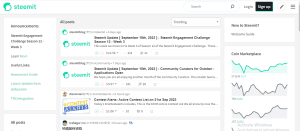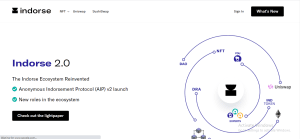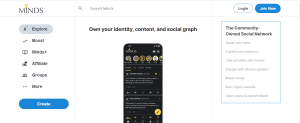Dapps for Social Media: The Decentralized Future of the Internet
The concept of blockchain and its ecosystem is no longer new. The blockchain sector has seen a lot of growth and development, including the development of dApps. Anyone keeping up with the latest developments in the blockchain sector would be aware of the phrase “dApp.”
Most DApps are based on Ethereum and have several components that ensure the program runs according to plan.DApps differ from traditional centralized applications in many ways. These differences also make dApps a better alternative to their ‘more traditional’ counterparts. Designing a successful dApp requires understanding its features, applications, benefits, and prospective markets.
Here is all you need to know about dApps, including what they are, how they operate, and their benefits and drawbacks.
Decentralized Applications: dApps Overview
Decentralized applications, or dApps, are computer programs or digital apps that run on a peer-to-peer network of computers or a blockchain. A single authority can only govern these applications if they are decentralized. They are distinct because they support P2P despite having graphic elements comparable to those of other software applications. One of the most popular Dapps development platforms for developing dApps is Ethereum. DApps are created for various applications, including finance, gaming, and social media. There is a recent jump in the demand for a Dapps Development Company.
Applications of Dapps in different industries
Gaming
The popularity and revenue of Defi games have skyrocketed in a short period. The characters in the game can be owned in the form of Non-Fungible Tokens (NFTs), which can then be sold. The virtual currency used in Defi games is a real cryptocurrency. The combination of these elements has led Defi Games to create a new gaming genre, Play To Earn.
Social Media
For example, decentralized social networking solutions have been created and are in operation by Peepeth. This platform is similar to Twitter in that it eliminates censorship from a central source; however, most users would need to consent to the censorship of this Decentralized application, thus returning control to the consumer. Additionally, using bots to increase Twitter trends is a major issue. Platforms such as this one charge a small fee (GAS) for creating a new account, which makes spamming more costly.
How DApps Are Boosting Social Media?
Decentralized apps, or dApps, have the ability to greatly influence and advance social media in a number of ways:
Privacy and Ownership of User Data:
Traditional social media platforms frequently gather enormous volumes of user data, raising questions regarding data misuse and privacy. Decentralized applications built on blockchain technology give users more control over their data. Users have the option to decide what information is shared, and because their data is housed on a decentralized network, there is a lower chance of data breaches and unwanted access.
Ownership and Monetization of Content:
Decentralized applications give content producers more control over the distribution of their work and the ability to retain ownership of their intellectual property. Creators can be paid directly for their work through blockchain-based smart contracts, doing away with the need for middlemen like advertising networks. Fairer remuneration and incentives for content creation may result from this.
Censorship Resistance:
The propensity of centralized social media platforms to filter material and restrict free speech has drawn criticism. Censorship resistance. Running on decentralized networks, dApps are more censorship-resistant. It is difficult for any one entity to manage or censor information because it is distributed among numerous nodes.
Global Reach and Accessibility:
Decentralized applications are available to anybody with an internet connection, giving people in places where access to conventional social media is constrained a platform. This might make it easier for people all around the world to communicate and exchange ideas.
Incentivized Engagement:
Some decentralized apps use token payouts to encourage user participation. Users can earn tokens by contributing to the platform’s development, moderating material, or participating in discussions. Gamification can promote lively, active communities.
Interoperability:
Decentralized social media applications may be created so that they can collaborate and communicate with other decentralized programs and services. Users may be able to easily share material and information across many platforms thanks to this interoperability, which can result in a more seamless user experience.
Community Governance:
Many dApps use decentralized governance processes in which the community as a whole decides on platform rules, updates, and changes. This can reduce worries about centralized power in social media and promote more open and democratic decision-making.
Reduced Ads and Algorithms:
Traditional social media sites frequently rely on algorithms that prioritize specific content and bombard users with ads. DApps can offer different business models that give consumers greater control over their feeds and less exposure to adverts.
Enhanced Security:
The solid security characteristics of blockchain technology are the basis for many decentralized applications, and they are well-recognized. Users’ confidence in the security of their accounts and data has increased as the decentralized system has lowered their risk of identity theft and hacking.
Micropayments and Tipping:
A few dApps support tipping and micropayments on the platform. Users can give content creators direct support or acknowledge others for important contributions, encouraging a culture of gratitude and cooperation.
Community development:
User Engagement and community development are frequently given top priority on decentralized social media platforms. Users can more easily connect with others who share their interests by focusing on smaller, specialist communities.
Although dApps have many benefits for social media, it’s vital to remember that their development and adoption are still in their early phases. For widespread implementation, issues including scalability, user experience, and regulatory compliance must be resolved. However, when blockchain technology develops further, decentralized applications have the potential to alter how we use and engage with social media completely.
What Makes Social Media dApps the Future?
Security is The primary reason modern businesses transition to a decentralized structure. Nevertheless, the blockchain may offer a more effective solution to social media issues. By examining examples from daily life, we may be able to assess the potential for social media dApps.
1. Steemit
This decentralized social media network, billed as the first of its kind on the blockchain and modeled on Reddit, rewards users with Smart Media Tokens for their posts.
2. DTube
DTube is a decentralized application of YouTube that allows users to upload, vote on, and comment on video content without any restrictions. It allows users to disable videos but not to delete them.
3. Peepeth
Peepeth takes pride in being “spam resistant” (similar to Twitter), as posting requires Ethereum, and any content that does not adhere to their code of conduct will be subject to deletion.
4. Indorse
Indorse, similarly to LinkedIn, generates revenue through connections, endorsement opportunities, and most interactions. Tokens can be earned to cover the cost of pages and advertisements.
5. Minds
Mind is a social networking platform similar to Facebook, enabling users to create communities and groups of people sharing similar interests. To increase the visibility of posts, users can pay for them with Minds tokens. Additionally, users can interact with each other to earn tokens.
See Also: Exploring the Promise and Challenges of Web3 Authentication
To Sum It Up
The genuine potential of decentralized Apps is now readily apparent to individuals and organizations, so their popularity is rapidly increasing. They always evolve to improve functionality and include features that make use easier. To cater to a wide range of industries and businesses, dApps are created using technology, innovation, and creativity.
Understanding how decentralized apps operate and building them requires a strong understanding of the blockchain ecosystem, which is crucial in establishing a dApp’s backend. The number of blockchain apps has grown, as has the demand for experts who can unlock the system’s potential and create breakthroughs like dApps and Hire Decentralized Application Developers.






